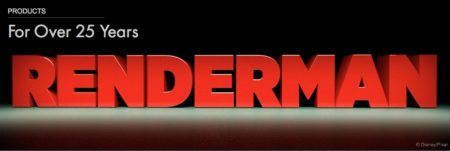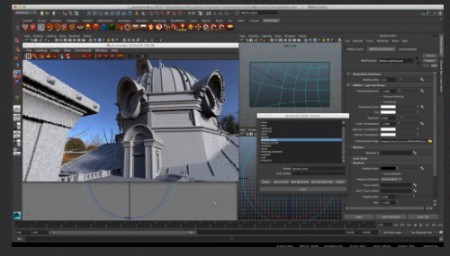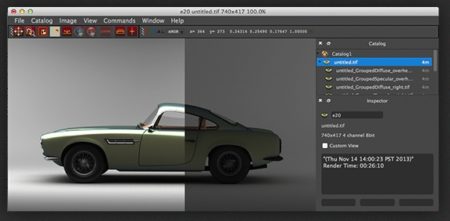Pixar is world-famous for its feature-length Oscar-award winning movies, beginning with ‘Toy Story’, staring Tom Hanks. But to most 3D professionals, including a lot of CAD professionals, its chief technology—RenderMan—is equally as famous for its astounding visual qualities. With each successful Pixar hit film, following the amazing Toy Story, the animation studio would push the envelope for all to see.
Pixar RENDERMAN 19
Version 19 Details
The latest release of RenderMan software is version 19 and it introduces what the company is calling its RIS Framework. Once again the company claims that RenderMan 19 is a game-changer and includes a radically new rendering paradigm: RIS, a highly-optimized mode for rendering global illumination (GI), specifically for ray tracing scenes with heavy geometry, hair, volumes, and irradiance with world-class efficiency all in a single pass.

01 – A partial screen grab from the RenderMan website. RenderMan is 25 years old. Version 19 offers super new features and technology and is aiming to be more accessible than ever before, with tie-ins to Cinema 4D, Blender, Lightwave and others (courtesy of Pixar/Disney)
Pixar says this leap in technology offers best-of-class in rendering for both VFX and feature film animation. Along with enhancement to their efficient REYES render mode, RenderMan 19 offers what the world leader in movie CG animation says is the most “flexible, powerful and reliable tool for rendering cinematic imagery.”
Here’s what’s new:
- RIS—this new trace rays rendering system is completely written in C++ for both speed and memory efficiency when rendering multi-bounce global illumination (GI) for complex production scenes
- Progressive Rendering with Image Check-Pointing—in the first pass of a progressive render all the scene elements are rendered and allow incremental feedback for an entire frame all at once
- Interactive Lighting and Look Development—so fast artists can now quickly light scenes and construct shader networks for immediate feedback
- Light Transport & Integrators—Integrators take camera rays and return shaded results to the renderer, plus API for custom integrators.
- Global Illumination Sampler—pools light samples for all sources in the scene, thus dramatically increasing the number of lights that can be used at any given time
- Ray Traced Subsurface Scattering—the results of cutting edge research at Disney Research Zurich (ETH), Switzerland
- Open Standards—Pixar has committed to developing and adopting standards for animation and visual effects including popular open standards like: Alembic, OpenColorIO, OpenEXR, OpenSubdiv, OSL, RSL, SeExpr and others…
- Shader Libraries—RenderMan 19 ships with advanced shader libraries for creating a wide range of physically accurate looks and they all benefit from RIS
There are other key improvements too, including Geometric Area Lights, Gobos, Emissive Geometry, Camera Projections and many other key items like Adaptive Sampling and a Daylight Simulator. And polygons don’t scare RenderMan!
Pricing
Importantly in the new RenderMan 19 is the new free Non-Commercial RenderMan to be released in early 2015. Examples of non-commercial use include evaluations, personal learning, experimentation, research, and the development of tools and plugins for RenderMan. There is a FAQ for further information.

02 – Primarily today RenderMan runs inside the Autodesk Maya workflow but is also a plugin for KATANA. Here is a capture from a video showing it in action in Maya. (courtesy of Pixar/Disney).
RenderMan 19 is newly packaged with respect to the various versions before, like RenderMan Pro Server. You can read more below. Now there is just RenderMan 19. The price per seat is 495.USD per license. Pixar Tractor licenses are 100.USD per seat.
More licensing information can be found here.
Platforms and 3D App Support
RenderMan 19 bridge compatibility works across Autodesk Maya and The Foundry’s KATANA and are fully supported by Pixar. RenderMan 19 works on Mac OS X, Linux and Windows for Autodesk Maya. KATANA runs on 64-bit Linux only. And CentOS/RHEL 5.4 to be precise.
Currently third-party support for RenderMan 19 is underway for Maxon’s CINEMA 4D, Houdini by Side Effects Software, and Autodesk 3ds Max. Rhino, modo, LightWave, and Blender are not supported but there are discussions circulating about support for RenderMan.
RenderMan 19 now includes all the components of the old RenderMan Studio with the exception of Pixar Tractor, its batch rendering tool. That is a separate license. A single RenderMan 19 license gains you the following:
- RenderMan for Maya plugin (where you put RenderMan to work within Maya workflows)
- Slim—a powerful shader management and shader development tool (standalone and integrated)
- it™—Pixar’s image viewer tool designed to make working with images in the heat of production as efficient as possible. HDR imagery can be viewed with full luminance data viewable. And there is support for scriptable image processing. Read more about it™ here
- RenderMan Pro Server—this has been combined into RenderMan 19. An FAQ here explains licensing questions quite well.
With a single RenderMan 19 license you can access any combination of batch renderer and artist interface softwares (e.g.: Slim, it™, RenderMan for Maya plugin) and vary usage depending on production needs.

03 – Renderman 19 is newly packaged and includes several distinct applications as well as RenderMan Server Pro functionality. Here it the iT image app shown, which runs on OS X. (courtesy Pixar/Disney)
Pixar’s Tractor 2 is a distributed processing solution that helps in queuing and dispatching tasks. Tractor has three components and all three have various platform support, varying from Linux, OS X, and Window. Only Mac OS X can run all three components of Tractor.
next page: The Future of RenderMan—Ed Catmull Talks in Video



Reader Comments
Greg Conyngham liked this on Facebook.
Comments are closed.